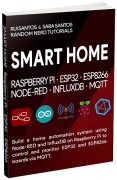The CP210x USB chip turns a USB connection into a regular serial port which allows your computer to establish a serial communication with microcontrollers like the ESP32 or ESP8266. To program or exchange information between your computer and an ESP32/ESP8266 chip, you need to install the CP210x USB to UART Bridge Virtual COM Port drivers. This guide shows to install the drivers on Mac OS X.

We have a similar guide for Windows PC: Install ESP32/ESP8266 USB Drivers – CP210x USB to UART Bridge
ESP32/ESP8266 USB Chip – CP2102/CP2104
If it’s your first time using an ESP32/ESP8266, it’s probably that if you plug the ESP board into your computer, you don’t see your ESP’s COM port available. This means you don’t have the drivers installed. Take a closer look at the chip next to the voltage regulator on the board and check its name. For this board, it comes with the Silabs CP2102 chip.

The ESP32 DEVKIT V1 DOIT board and many other ESP32 and ESP8266 NodeMCU modules use the CP2102 or the CP2104 chips.
If you install the CP210x drivers as explained in this blog post, you’ll ensure that the USB connection and communication will work for any ESP board that uses those USB chips (starting with ‘CP210’).
Note: another popular USB chip used by many ESP32 and ESP8266 modules is the CH340. Always check the datasheet of your board to make sure you identify the right USB to UART communication chip that’s being used in your board.
Installing CP210x USB to UART Bridge VCP Drivers (Mac OS X)
Start by downloading the CP210x USB Drivers from the official website. If you are on Mac OS computer, you need to download the CP210x Mac OSX Driver folder highlighted in the image below.

After downloading the Mac OSX VCP Driver, unzip the installation files.

Open the unzipped folder and double-click the SiLabsUSBDriverDisk.dmg file to start the installation process.

Open the Install CP210x VCP driver file:

Click the “Open” button.

Follow the installation wizard and complete all the steps.

In some cases, your computer might block the installation, so you need to open your System Settings.

Then, click the “Allow” button to allow the CP210x drivers to be installed.

Finally, you should see the Success message.

In the Arduino IDE, select your ESP32/ESP8266 board USB Port, as shown earlier. Ours is /dev/cu.SLAB_USBtoUART Serial Port (USB).

That’s it! You should now be able to see the Serial Port of the ESP32/ESP8266 in Arduino IDE. You can upload a new code to your ESP board to test it.

Wrapping Up
We hope you’ve found this quick guide useful. Want to learn more about the ESP32? We recommend the following ESP32 tutorials to get started:
- Getting Started with the ESP32 Development Board
- ESP32 Digital Inputs and Digital Outputs (Arduino IDE)
- ESP32 Web Server Tutorial
- ESP32 Pinout Reference: Which GPIO pins should you use?
If you’re serious about learning about the ESP32, we recommend taking a look at our best-selling eBook:
If you like ESP32 make sure you subscribe to our blog, so you don’t miss upcoming projects.
Thanks for reading.







